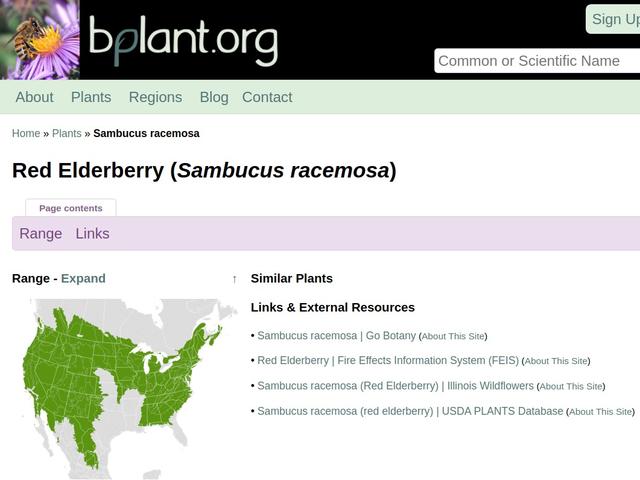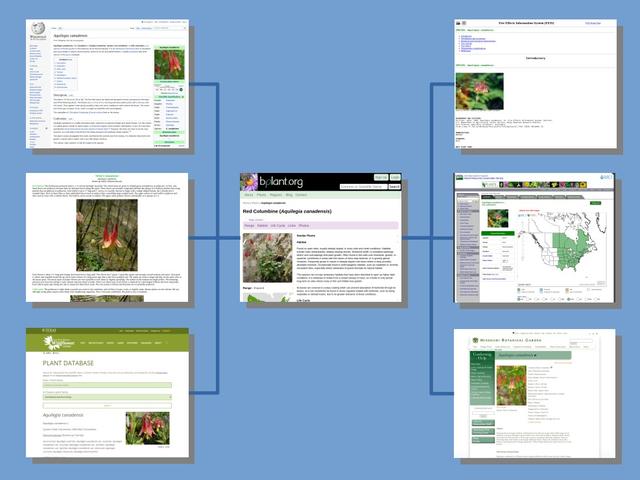Interlinking Databases for Plant Research
November 11th, 2020 by Alex Zorach
We have begun interlinking our plant articles with other plant websites and databases, so that you can use our site as a reference to find pages on a given plant species, all in one place.When researching plants online, it quickly becomes apparent how many different resources there are. A particular species will have detailed articles on certain websites, but nothing on others. And while some resources are easily found through a web search, other valuable resources are harder to discover.
There are multiple reasons for these disparities, including the regional distribution of plants, the incompleteness of databases, the different focuses of various sites, and the fact that some sites are more easily crawled by search engines than others.
Regionalism: Global, National, Local
Every plant is limited in range, so it makes sense that most plant resources would be limited to a particular region. But there are plant databases and websites covering various scopes from hyper-local all the way up through global.Global Plant Websites
There are a few global plant resources, like Plants of the World Online (POWO) and eFloras.org, and resources that cover more than just plants, such as iNaturalist and Wikipedia. However, even if in theory each of these sites could cover all plants, in practice they are spotty.Some Wikipedia articles are better than others, and the articles on many more esoteric plant species don't even exist yet. Plants native to other regions of the world often only have articles in languages other than English. Similarly, POWO has a fairly complete skeleton of data, but the pages are more extensively developed for some species (and some regions and taxonomic groups) than others. eFloras.org is a collection of various online manuals of plant systematics from different parts of the world, each of which has regional scope, and each of which is also incomplete. And while iNaturalist has a skeleton of pages for most documented species, the actual data tends to concentrate on conspicuous, easily-identified plant species, and regions near population centers and/or popular ecotourism spots.
National or Continent-Based Resources
There are also numerous resources at the level of North America as a whole, or the US, three of the biggest being the USDA PLANTS database, BONAP, and Flora of North America (which is included in eFloras.org). There are also a lot of other databases associated with U.S. federal agencies, such as the Fire Effects Information System (FEIS), or the Ecoregional Revegetation Application (ERA) run by the US Federal Highway Administration. The FEIS has only limited information on plants, but has extensive ecological information for species on which they have articles, and which tends to cover nearly all of the most important tree species across the continent, as well as a selection of the more important grasses and herbaceous plants.Regional and Local Resources
On top of these there are regional and local resources, such as Native Plant Trust's Go Botany, which covers New England, or Missouri Botanical Garden's Plant Finder which covers plants native to a broad area, as well as introduced plants, but tends to write from the perspective of their use in gardening and landscaping in the Missouri area. On top of this are numerous state-sponsored educational resources, such as state agricultural extensions, material hosted on various university sites, and various herbaria.Different Resources for Different Interest
Each of the resources above has its own purpose. For example, eFloras.org and Flora of North America serve as authoritative sources on plant systematics and taxonomy, with in-depth information that an expert can use to distinguish tough-to-identify plants, but that may not be as accessible to a layperson. Some sites focus more on the ecology of plants in the wild, considering factors like habitat and faunal associations, whereas others are more focused on uses of plants, such as in landscaping or gardening, or other uses like how The Wood Database describes the physical properties, uses, and workability of different species used for lumber.Limitations of Web Search
Web searches are useful, but they can be unreliable for exhaustively checking whether or not something exists. Pages may not be indexed, or search results may not be returned in a consistent order, with one database or resource ranking higher for certain searches but ranking lower or not showing up at all for others.Collecting Information in One Place
There are great benefits to having one single resource or reference that you can use as a branching off point for other resources. And here is where our latest undertaking comes in.We have a total of 25200 pages corresponding to most plants documented occurring in the wild in North America. Each of these is already linked to its corresponding page on the USDA Plants Database, but we have begun linking them with other databases as well. You will now find a "Links" section on the page for each plant, including stub pages where we have yet to research and write any of our own text.
 You can find a Links section on any of our plant pages that have been interlinked with other databases, even if they are stub pages that do not have a full article yet.
You can find a Links section on any of our plant pages that have been interlinked with other databases, even if they are stub pages that do not have a full article yet.The main goal of the Links section is to make our site useful as a resource where you can see what other sites or databases have an entry for a particular plant. However, there is an additional beneficial side-effect, which is that these links may also help search engines to discover some of the lesser-known plant websites and see them as relevant and useful so that they too are returned higher in search results. The landscape of plant websites is not as interconnected as it could be, and we hope that our linking to sites can encourage and facilitate all sites to link to each other.
"About This Site" Links
Note also that next to each main link is an "About This Site" link; these links take you to a summary page that describes what the database is, including relevant points such as what its scope is (global, national, regional, or local) and its focus, both of which can be important for knowing how to interpret the material. I.e. if the reference is local but from outside your region, its material on ecology might be less relevant, or its commentary on plant ID might omit species you need to check against in your area.How much is added?
As of publishing this post, we have interlinked five websites, for a total of 30,704 interlinked records. You can find a list of the websites we have interlinked with, including both completed and in-progress projects, under the new Websites section of our site.Run a plant website? Please get in touch!
If you run a plant website and are interested in any help interlinking your site with ours or with other databases we have already listed, please get in touch with us. We would be glad to help you, such as by sending you exported tables of data that could allow you to automatically import links rather than having to type them in one-by-one.And, of course, if we haven't linked to your website yet, we are also interested in doing so, and you can help us by sending us data to help us automate the interlinking process!
Try It Out!
Try out the new tools by typing a species of interest, by common name or scientific name, into our search box at the top of each page, and seeing what links show up!Archive of All Blogs
The Bias Against Tall Plants, November 11th, 2025
A Focus on Goldenrods (Solidago sp.), July 23rd, 2025
Disturbance and its Role in Plant Habitat Preferences, May 29th, 2025
What "Native" or "Introduced" Mean: Myths and Misconceptions, March 11th, 2025
Smarter & More Informative Search Results, January 13th, 2025
The Effect of the 2024 US Election on Plant Biodiversity and bplant.org, October 30th, 2024
The Problems With Nursery-Bought Plants, And The Solutions, October 8th, 2024
More Databases Linked & Search Improvements for Scientific Names, July 9th, 2024
Choosing The Best Common Names For Plants: Challenges & Solutions, April 19th, 2024
Range Map & Taxonomic Update Progress, January 31st, 2024
Giving Thanks To Everyone We Rely On, November 22nd, 2023
Thinking More Deeply About Habitat, April 5th, 2023
2022 Year-End Summary: Successes & New Goals, February 15th, 2023
New Databases Linked: Flora of North America & NatureServe Explorer, November 11th, 2022
All Range Maps 2nd Generation, Taxonomic Updates, & Fundraising Goal Met!, September 29th, 2022
More Range Map Improvements, POWO Interlinking, And Notes Fields, June 7th, 2022
Ecoregion-Based Plant Lists and Search, March 30th, 2022
Progress Updates on Range Maps and More, February 10th, 2022
The Vision for bplant.org, December 9th, 2021
New Server: Software & Hardware, August 30th, 2021
More & Improved Plant Range Maps, July 19th, 2021
A Control Section for Invasive Plants, April 15th, 2021
Progress Bars & State Ecoregion Legends, March 11th, 2021
Our 2020 Achievements, February 9th, 2021
Interlinking Databases for Plant Research, November 11th, 2020
A New Homepage, Highlighting Our Articles, July 29th, 2020
A False Recovery, But North Carolina's Ecoregions are Complete!, June 9th, 2020
We're Back After COVID-19 Setbacks, April 3rd, 2020
Help Us Find Ecoregion Photos, February 27th, 2020
What We Achieved in 2019, December 30th, 2019
Plant Comparison and ID Guides, October 30th, 2019
We Are Now Accepting Donations, October 14th, 2019
US State Ecoregion Maps, New Footer, Ecoregion Article Progress, and References, September 19th, 2019
Tentative Range Maps of Native Plants, August 12th, 2019
Ecoregion Locator and Interactive Maps, July 10th, 2019
Using Ecoregions Over Political Boundaries, May 13th, 2019
How We Handle Wild vs Cultivated Plants, April 16th, 2019
A Blog To Keep People Updated On Our Progress, April 8th, 2019
Sign Up
Want to get notified of our progress? Sign up for the bplant.org interest list!



